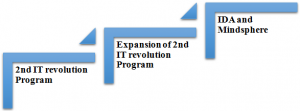Digitalization at Siemens Case Study Solution
Thus, Siemens decided to shut the door of IBM for Siemens as it was giving a fully-pledged competition to it in Singapore. This is the point where the launch of 2nd IT Revolution Initiative took place with fifteen or more businesses which mainly included the investments in digital future in order to change the whole business model with the changes in industry.The key aspect of the strategy approach was to shift to vertical IT including software for the core processes i.e. manufacturing systems, and distribution grids.
The core strength of Siemen laid in its vertical information technology approach with expertise in specific domains. Despite the challenges to successfully compete against such big players required capital for which Siemen decided to sell SIS. In 2011, the take-over of SIS by the French IT firm Atos becoming a part of Siemen served as a 15 percent strategic share of stakeholders with a commitment of € 5.5 billion to a contract of seven year for future IT services.
The move from horizontal IT to vertical IT was right approach as it identified its strength. Initial problems were a source of long-term benefit. To stand up against the competitors in the market using its core strengths and improvement required differentiation as it seemed that its processes were not confidential and imitable as IBM started learning which might pose a long-term threat to the organization resulting in financial instability.
Siemens Digitalization Program:
With the approach to widen the impact of digitalization from the units of the businesses in the Program of 2nd Revolution, Siemens decided to introduce a digitalization Program in 2014. Due to changes in the industry and shift to internet of things, many organization had been experiencing issues including Siemens. This primarily included learning from prior experiences, which factually stressed accountability and targets. With the need of explaining the divisions on advancement in digitalization, each division wanted assistance to peers to step up. For this purpose, in order to make EAD more tangible, the categorization of business took place to digitalization components.
In order to overcome the issues arose due to industry transition, Siemen decided to set a meeting after every three to six months in localities such as Silicon Valley primarily to exchange ideas regarding the agendas of digital marketing approach on the basis of digital culture of the organizations. Thus, the sharing of ideas in the meeting assisted each division with the issues which were developed while each division started taking their own digitalization initiatives to receive honest feedbacks, setting up guidelines, assisting in the processes of governance and ensuring transparency.
Digitalization Program (IDA, Mindsphere):
Creation of platform was purposely for the management of operations which mainly included IDA with the focus to remain in tactic with the vertical units of the business related to know-how the consumers. The approach of Siemen’s IDA platform was considered to serve as a competitive advantage against its strong competitors in the industry such as IBM and Google. As the processes proceeded, the standards were limited to technical to just approve the funding required for operational services.
The process was somehow in line with the strategic approach of Siemens to stick to its strength. Despite the introduction of Mindsphere had shifted the focus of Siemens’ from being more dedicated on synergies despite of focus. Although IDA and Mindsphere benefited Siemens by ensuring its sustainability through the industrial verticals and acceptance by the divisions involved and from their customers considering on premise solution which served as a centred application to monitor, predict, efficiency and reduction in consumption of power particularly in sites of manufacturing.
Approaches to Digitalization (Siemens vs GE):
GE had top down or centralized approach to digitalization. GE has always been a prime example of industrial company in throes of digital transformation. The digital transformation delivers shorter manufacturer cycles, higher productivity and reduced downtime of machine at GE. In September 2015, GE has contemplated to develop predix.io where the organizations would be able to build custom application on predix.io. Currently, GE on the basis of the deep technology, experience and industry expertise helps customers in accelerating their journey of digital transformation with GE digital predix portfolio of IIoT and industrial application platform.
In contradiction to GE, Siemens have noticed various industrial changes in perspective of digitalization also, after electrification, the company has been challenging with the reduced growth and financial loss due to which it has embraced the digitalization to strengthen a business by potentially increasing and maintaining profitability and improving reliability. At Siemens, the digitalization have significantly increased the company’s performance and availability. Additionally, the different approaches of GE and Siemens for digitalization have enabled these organizations to centralize key aspects of process management and system.
Digital Future at Siemens
Accomplishment, Challenges and Recommendations:
In 2015, the movement of all businesses of Siemens towards the digitalization of services and products have successfully contributed to its growth. For instance, one of its accomplishment include the reimbursement to the passengers for more than 15 minutes delay with a guarantee of providing them with 99.9 percent performance leading to switch of 60 percent to switch from air travel to rail. Additionally, Siemens have valuation of one time sales which is considered normal in the industrial organization.
The key challenges includes attraction of young customers, improvement in the internal digitalization process, using different styles of digital approach with focus on creating value for customers. Thus, brushing up with the marketing of influencer interacts with the sentiments of customers surrounded by sponsored posts of influencers to be more in line with the advertisements despite the validation of word of mouth. Secondly, increasing the average rate of conversion considering the approach to right people and right process effectively making your competitor to go for an end-run. Lastly, performing GAP analysis will significantly provide with the ability to target the manual business processes hindering the successful and efficient digital transformation using the approach of digitalization.
Thus, as Siemens is performing quite well in the industry and has improved its operations since its transition from electrification to digitalization. The organization mainly requires improvement in the areas of bringing improvement in the internal processes for which GAP analysis has been suggested with retaining the criteria of half yearly meetings to evaluate the issues faced by each division will significantly result in effective management of operations of the organization.
Appendices:
Appendix A –Characterization of Digitalization
Appendix B – Recommendation
This is just a sample partical work. Please place the order on the website to get your own originally done case solution.
How We Work?
Just email us your case materials and instructions to order@thecasesolutions.com and confirm your order by making the payment here











